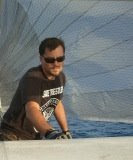So while gluing the rail strips to the frame, I've noticed the challenge of getting the rail strips to bend at the nose and lay flush with the shape of the frame at the nose. This is less of an issue at the mid section of the frame and tail, but as the shape of the frame narrows at the nose, the kit rail strips will tend to lay more vertically rather than curving with the shape of the frame. This happens because there’s no change in thickness of the rails from the nose to mid point and tail areas. So if you want thinner rails based on the design of the frame at the nose, you may have to get creative and think of different building solutions for this. The Grain builder's manual briefly mentions blocking for this step, but with no specific instructions. So based on what's been said over at the Tree to Sea Builder's Forum, I'm taking Rich's advice...keep building, then cut off a portion of the rail strips at the nose, and block it once I finish gluing down all the rail strips.
To illustrate this better, here's a picture showing the thinness at the nose of the board and a cross-section sketch of the rail strips at the mid area of the board. The planks being glued down at the nose will cover more surface area. This also means the rail strips and/or blocks at the nose will be sanded down more compared to the mid section and tail area of the rails. The cross-section sketch shows how this should form at the mid section of the board. Imagine the same for the nose area as you are forced to rely less on a thick frame structure for gluing. For this reason, the option to use blocks at the nose makes sense. Maybe over time and with more experience I'll stick to the manual for this step, but if you're building your first kit, don't stress out if you later decide to block the nose. As a beginner builder, you may find that getting the rails to bend just right at the nose is just not worth it. Besides, if you block the nose, you'll always have more surface area to work with while shaping and defining the nose.
















No comments:
Post a Comment